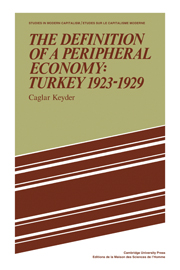3 - Structure of the manufacturing sector
Published online by Cambridge University Press: 06 July 2010
Summary
Introduction
Industrial development in the periphery has variously been interpreted as a necessary stage to be reached in an isolated and unilinear history or as an impossible goal attainable only through a challenge to peripheral status. It has become more apparent in the post Second World War era that the location of industrial, like all other economic activity, follows upon the logic of the world economy. Thus, there are no definite rules as to the absence or presence of particular industries, rather the rules of profitability determine the particular development of the means of production. Within such a framework it becomes easier to analyse the structure and the development of peripheral industry.
Before the Second World War most peripheral economies were characterised by the coexistence of traditional crafts whose heritage derived from the peripheral social formation itself, and modern manufactures which were a result of the integration process. Although there are similarities, we must be careful to distinguish traditional crafts from modern small industry, which exists in a much closer articulation with modern manufacturing. Traditional crafts remained literally traditional despite a growing volume of exchanges with the modern manufacturing sector: their types of activity, technology, and markets were not yet transformed under the impact of a changing economy. Modern industry, on the other hand, could be seen as a necessary component of a growing degree of world economic integration. In an open economy, it was the nature and the direction of commercial flows which determined profitability and consequently the nature of investments.
- Type
- Chapter
- Information
- The Definition of a Peripheral Economy: Turkey 1923–1929 , pp. 46 - 67Publisher: Cambridge University PressPrint publication year: 1981



